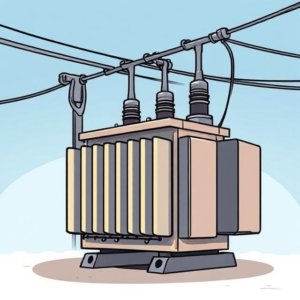Transformers Efficiency:
Transformers are devices used to change the voltage of electrical energy (either increasing or decreasing it) to make it easier to transport over long distances or to use with different devices. The efficiency of a transformer is a measure of how well it converts electrical energy from the primary side (input) to the secondary side (output) without losing too much energy.
In simpler terms, efficiency is about how much of the electrical energy that enters the transformer actually gets used on the other side, and how much is lost as heat or other forms of energy.
transformer efficiency is about how effectively electrical energy is transferred from the primary to the secondary side. It’s mostly impacted by core losses, copper losses, and design factors, and modern transformers are highly efficient, with losses kept to a minimum.

Factors Affecting Transformer Efficiency
Energy Losses in a Transformer
Core Losses (Iron Losses):
The core of the transformer is made of iron or steel, and when electricity flows through the transformer, it causes the core to magnetize and demagnetize. This process creates friction and heat, which wastes some of the energy. Core losses are mostly constant and don’t change much with the load on the transformer.
Two types of core losses: hysteresis loss and eddy current loss.
Copper Losses (Winding Losses):
The windings of a transformer are usually made of copper. When current flows through the windings, the resistance of the copper causes energy to be lost in the form of heat. The more current flowing, the higher the copper losses. These losses increase when the transformer is loaded more heavily.
Leakage Flux:
Not all of the magnetic flux created by the primary coil is perfectly transferred to the secondary coil. Some of it “leaks” out, which can lead to a loss in efficiency.
Stray Losses:
These are minor losses that come from other effects, like vibrations, noise, and small imperfections in the transformer.
Factors that Influence Efficiency
-
- Load: When a transformer is operating at full load (its maximum capacity), it tends to be more efficient. However, under light load or no load at all, losses might become a higher percentage of the total power.
- Quality of Materials: Transformers made with better materials (high-quality copper for windings and high-grade iron for the core) will have lower losses and higher efficiency.
- Design: The design of the transformer also impacts its efficiency. For example, a well-designed transformer with fewer losses due to leakage flux will be more efficient.
- Operating Frequency: Higher frequency transformers can have higher losses due to core hysteresis and eddy currents. That’s why transformers used for lower-frequency applications (like power grids) are designed with specific materials and construction methods.
Simple Example
Imagine you have a transformer that receives 1000 watts of electrical power at the input. If the transformer is 98% efficient, it will lose 2% of the power, and only 980 watts will come out at the secondary side.
- Input Power= 1000 watts
- Efficiency= 98%
- Output Power= 1000 watts * 98% = 980 watts
- Loss= 1000 watts – 980 watts = 20 watts lost as heat, noise, or other inefficiencies.
Why Efficiency Matters
High efficiency in transformers is important for:
- Reducing Energy Waste: The less energy wasted as heat, the better for both economic and environmental reasons.
- Saving Costs: In large-scale applications (like power grids), even small improvements in efficiency can result in large savings in energy costs.
- Improved Performance: High-efficiency transformers help in maintaining a stable and reliable power supply, especially in critical applications like hospitals, data centers, or industrial plants.
Tags: copper losses, core losses, cost savings, economic efficiency, eddy current loss, efficiency calculation, efficiency percentage, electric power transmission., electrical distribution, electrical energy transfer, Electricity, energy conservation, Energy Conversion, energy optimization, energy wastage, energy-saving devices, environmental impact., full load efficiency, heat loss, high-efficiency transformers, high-grade iron, hysteresis loss, industrial applications, input power, iron losses, leakage flux, load conditions, low-frequency transformers, material quality, maximum output, minimal losses, no load losses, noise, operating frequency, output power, Performance Improvement, power grid efficiency, Power Loss, primary winding, pure copper windings, reliable power supply, resistance heating, secondary winding, stray losses, thermal management, transformer design, transformer efficiency, transformer reliability, Transformers, vibrations, winding losses


